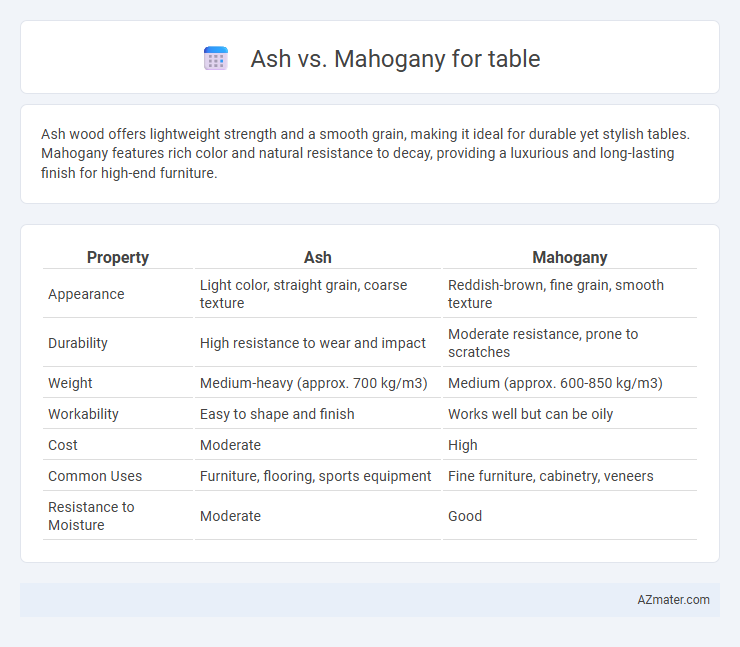Ash wood offers lightweight strength and a smooth grain, making it ideal for durable yet stylish tables. Mahogany features rich color and natural resistance to decay, providing a luxurious and long-lasting finish for high-end furniture.
Table of Comparison
| Property | Ash | Mahogany |
|---|---|---|
| Appearance | Light color, straight grain, coarse texture | Reddish-brown, fine grain, smooth texture |
| Durability | High resistance to wear and impact | Moderate resistance, prone to scratches |
| Weight | Medium-heavy (approx. 700 kg/m3) | Medium (approx. 600-850 kg/m3) |
| Workability | Easy to shape and finish | Works well but can be oily |
| Cost | Moderate | High |
| Common Uses | Furniture, flooring, sports equipment | Fine furniture, cabinetry, veneers |
| Resistance to Moisture | Moderate | Good |
Introduction to Ash and Mahogany Woods
Ash wood is renowned for its light color, distinctive grain patterns, and impressive strength, making it a popular choice for durable and stylish furniture tables. Mahogany wood, prized for its rich reddish-brown hue and fine grain, offers exceptional workability and timeless elegance in high-end tables. Both woods provide unique aesthetic and structural qualities, with ash delivering toughness and bright finishes, while mahogany emphasizes warmth and luxury.
Origin and Availability of Ash vs Mahogany
Ash wood originates primarily from North America and Europe, known for its strong, flexible grain and widespread availability in temperate forests. Mahogany, traditionally sourced from tropical regions including Central and South America as well as Africa, is prized for its rich color and fine grain but is less abundant due to overharvesting and stricter regulations. Ash tends to be more accessible and cost-effective for table construction, while mahogany, being rarer, commands higher prices and is often chosen for luxury furniture.
Color and Aesthetic Differences
Ash wood features a light, creamy color with distinct straight grain patterns, creating a bright and airy aesthetic ideal for modern and Scandinavian-style tables. Mahogany offers a rich, deep reddish-brown hue with a smooth, fine grain that adds warmth and elegance, suited for traditional and classic furniture designs. The contrast between ash's pale, natural tone and mahogany's darker, luxurious appearance influences overall room ambiance and stylistic appeal.
Grain Patterns and Texture Comparison
Ash wood features a pronounced, straight grain pattern with a coarse, open texture that offers durability and flexibility ideal for table surfaces. Mahogany exhibits a finer, more uniform grain with a smooth, closed texture, providing a luxurious feel and rich reddish-brown color that enhances elegant furniture designs. The contrasting grain structures and textures influence the table's aesthetic appeal and tactile experience, with ash emphasizing rustic charm and mahogany delivering refined sophistication.
Durability and Strength for Table Use
Ash wood is highly durable and offers exceptional strength, making it ideal for sturdy tables that withstand daily use and heavy loads. Mahogany features good durability with a dense grain, providing stability and resistance to warping but is generally softer than ash, which can affect long-term wear. For table use requiring maximum strength and impact resistance, ash is often preferred due to its superior hardness and resilience.
Workability and Ease of Crafting
Ash wood offers excellent workability due to its straight grain and moderate hardness, making it easier to cut, shape, and sand for table crafting. Mahogany, while slightly harder, is renowned for its smooth finish and natural resistance to splitting, providing excellent ease of carving and detailed woodworking. Both woods respond well to hand and machine tools, but ash typically allows faster shaping, whereas mahogany excels in fine detailing and a polished aesthetic.
Cost and Market Value Analysis
Ash wood typically costs less than mahogany due to its wider availability and faster growth rate, making it a more budget-friendly option for table construction. Mahogany commands a higher market value because of its rich color, durability, and association with luxury furniture, often leading to increased resale prices. Market trends show that tables made from mahogany retain value better in premium segments, while ash-based tables appeal to cost-conscious buyers seeking functionality and aesthetic appeal.
Maintenance and Longevity
Ash wood offers moderate maintenance with its natural resistance to wear and decay, requiring occasional sealing or oiling to preserve its durability and appearance. Mahogany provides superior longevity due to its dense grain and natural oils, which make it more resistant to moisture, pests, and warping, needing less frequent upkeep. Both woods benefit from regular cleaning and protective finishes to maximize lifespan, but mahogany typically outperforms ash in long-term resilience and maintenance ease.
Environmental Impact and Sustainability
Ash wood is known for its rapid growth and widespread availability, making it a more sustainable option compared to mahogany, which grows slowly and is often harvested from endangered tropical forests. Mahogany's extraction contributes significantly to deforestation and habitat loss, whereas ash is typically sourced from well-managed temperate forests with certified sustainable practices. Choosing ash for tables reduces environmental impact by supporting sustainable forestry and minimizing the carbon footprint associated with long-distance transportation of mahogany.
Which Wood is Better for Your Table?
Ash offers exceptional strength and a light, uniform grain that enhances durability and aesthetic appeal for tables, making it ideal for high-traffic use. Mahogany provides rich, deep color and excellent resistance to wear and moisture, ensuring elegance and long-lasting beauty in furniture. For a balance of durability and striking appearance, choosing ash excels in resilience, while mahogany is preferable for a luxurious, classic finish.

Infographic: Ash vs Mahogany for Table
 azmater.com
azmater.com